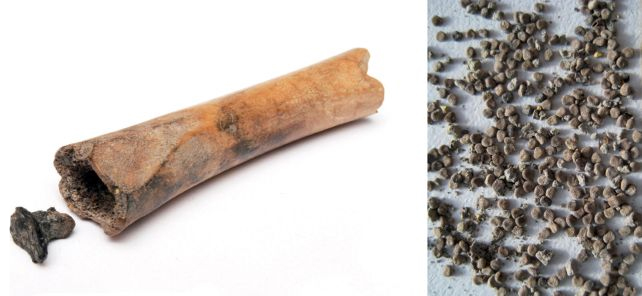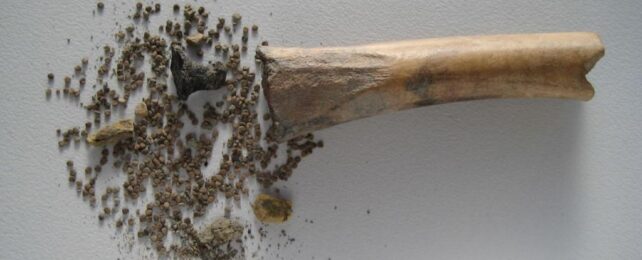An ancient bone dating back thousands of years is the first solid evidence that humans in Europe were collecting and storing a powerful and dangerous drug.
Deliberately hollowed out and plugged with birch tar, the bone – originally from a sheep or goat – was found to contain a large number of seeds of a plant called black henbane (Hyoscyamus niger).
A trio of researchers from Germany and the Netherlands have argued the plant material was being kept for a specific purpose.
In even small doses, black henbane, common throughout Europe, is dangerous. It contains the toxins hyoscyamine and scopolamine, and if eaten can result in tachycardia, convulsions, coma, and death.
If used carefully, however, the plant can induce hallucinations, or even be used as a medicine. Black henbane was found in the hospital of a first-century CE Roman fortress in Neuss, and the grave goods of a seeress buried in Jutland around 980 CE. The plant also appears in other archaeological sites around the Netherlands, often together with other medicinal plants.
However, very seldom can it be linked conclusively to human use.
"Since black henbane can grow naturally in and around settlements, its seeds can end up in archaeological sites simply by chance. This makes it difficult to prove if it was used intentionally by humans – whether medicinally or recreationally," says Maaike Groot, an archaeozoologist of the Free University of Berlin who led the research.
"The fact that, in our case, the seeds were found inside a hollowed-out sheep or goat bone sealed with a black birch-bark tar plug indicates that the henbane was stored there intentionally."
The bone was found as part of an archaeological assemblage at Houten-Castellum, a rural settlement that thrived from about 2,600 years ago to the end of the second century CE, near what is now Utrecht in the Netherlands. It's been a complicated site to unravel: so far, archaeologists have recovered some 207,000 pottery sherds, 1,400 metal objects, and 86,000 animal bone fragments that span the site's habitation.
It would be easy to overlook one caprid bone, amid thousands of others, but the researchers got lucky. While cleaning the bone, archaeozoologist Martijn van Haasteren of the Cultural Heritage Agency of the Netherlands accidentally knocked the birch tar plug loose, spilling small black seeds everywhere.
Two-thirds of the seeds were unfortunately lost at this point. But analysis revealed the remaining 382 seeds all belonged to the black henbane plant. Black henbane seeds had been found at the Houten-Castellum dig, but being stashed in a deliberately hollowed-out bone implies intent and importance, the researchers say. And, if full, the container would be able to hold around 4,000 black henbane seeds.
Even more interestingly, the bone is smooth and polished around the midsection, which could indicate frequent handling.

So what were the people of the Houten-Castellum settlement doing with black henbane? Well, that's the question, isn't it? Some scientists believe that black henbane was the crucial ingredient used to induce berserker rage, but it's hard to imagine an agrarian settlement needing to do that on a regular basis.
Rather, the researchers think that the purpose of the seeds may have been medicinal. At the time the bone was in use, the Netherlands was part of the Roman Empire. The researchers invoke the reports of Roman historian Pliny the Elder, who, in his Naturalis Historia of 77 to 79 CE, wrote that henbane could be used, in various forms, to treat coughs and colds, toothache, uterine pain, gout, tendonitis, flatulence, dry skin, and earache.
But it needs to be used properly, Pliny cautions, lest one incurs some of the iller effects of henbane application.
"It can be concluded therefore that henbane was used as a medicine, and that the dangerous side effects of its use were known," the researchers write in their paper.
Other archaeological discoveries contribute to theories that the deliberate use of henbane as a hallucinogen or medicament. The Houten-Castellum discovery suggests that perhaps the plant's ubiquity in archaeological sites is not so accidental after all.
"Instances where the intentional human use of black henbane can be proven beyond a reasonable doubt are rare. Only a handful of archaeological examples can be cited: one find in a grave and three finds from hospitals. The discovery at Houten-Castellum … therefore provides an important new case for the deliberate collection and use of seeds from this plant," the researchers write.
"We suggest that black henbane should not be disregarded as a wild plant so quickly in the future; the contexts of finds and associations with other plant species and artifacts should first be carefully considered."
The research has been published in Antiquity.
